

Le retour au bureau à la suite de la crise sanitaire de la COVID-19 : démarche pour une transition vers de nouvelles organisations du travail. Cocréer un monde du travail hybride engageant. Sloanreview.mit. Leaders of organizations large and small are struggling to define return-to-office strategies that reflect an appropriate balance of in-person and virtual interactions.
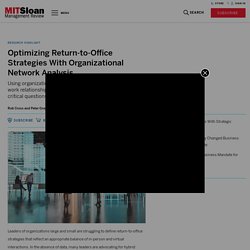
In the absence of data, many leaders are advocating for hybrid models based on intuition. You don’t have to look far to find examples of companies advocating for policies fueled by a desire to get back to “seeing people,” or the blanket belief that engagement or innovation is suffering in virtual settings. But such approaches don’t optimize business performance, innovation, or engagement, because they are blind to the informal networks through which collaborative work happens.
For most organizations, the balance between in-person and virtual interactions will certainly shift as a result of the pandemic. Email updates on the Future of Work.
Addressing Remote Work Fatigue is Key to Hybrid Work Success. To mitigate remote work fatigue, target three key stressors: digital distractions, virtual overload and difficulty disconnecting.
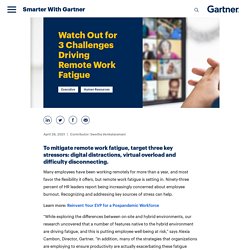
Many employees have been working remotely for more than a year, and most favor the flexibility it offers, but remote work fatigue is setting in. Ninety-three percent of HR leaders report being increasingly concerned about employee burnout. Recognizing and addressing key sources of stress can help. Guide distance sante. What Psychological Safety Looks Like in a Hybrid Workplace. Sorting out hybrid work arrangements will require managers to rethink and expand one of strongest proven predictors of team effectiveness: psychological safety.
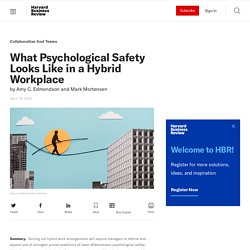
When it comes to psychological safety, managers have traditionally focused on... “Our office policy is that people should come into the office once per week. Now they are organizing a team meeting with 15 people. Les tiers-lieux, une solution au télétravail subi ? Hr leaders monthly magazine july. Going Remote Guide. 4 Imperatives for Managing in a Hybrid World. The hybrid workplace probably won’t last. Many people are convinced that post-pandemic corporate America will have a hybrid workforce, in which most people work from home and companies save on real estate and perks.
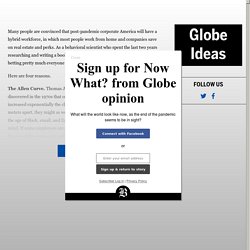
As a behavioral scientist who spent the last two years researching and writing a book about connection, trust, and belonging, I’m betting pretty much everyone eventually will go back to the office. Here are four reasons. The Allen Curve. Five Ways To Help Employees Manage Return-To-Office Anxiety. Aram Lulla is President, AF | HR | IT Divisions at Lucas Group.
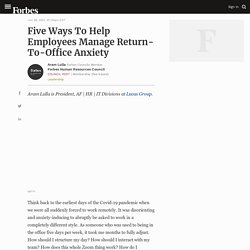
Think back to the earliest days of the Covid-19 pandemic when we were all suddenly forced to work remotely. It was disorienting and anxiety-inducing to abruptly be asked to work in a completely different style. As someone who was used to being in the office five days per week, it took me months to fully adjust. How should I structure my day? How should I interact with my team? Hybrid Work Is Here To Stay. Now What? Help Your Employees Who Are Anxious About Returning to the Office. Preparing for a Post-Pandemic Workforce - HRPA. When the pandemic hit, all businesses could think about was survival.
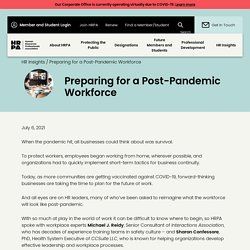
To protect workers, employees began working from home, wherever possible, and organizations had to quickly implement short-term tactics for business continuity. Today, as more communities are getting vaccinated against COVID-19, forward-thinking businesses are taking the time to plan for the future of work. 5 Myths About Flexible Work. What ‘Officism’ Means For The Hybrid Workforce (And How To Curb Its Effects) Director of People Analytics at Perceptyx, partners with large enterprises to create employee listening and people analytics strategies Flattening curves, lifted restrictions and accelerated vaccinations have placed the return to office in near sight.
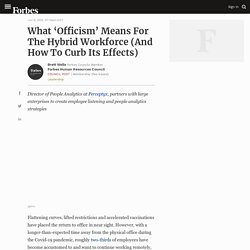
However, with a longer-than-expected time away from the physical office during the Covid-19 pandemic, roughly two-thirds of employees have become accustomed to and want to continue working remotely, at least in part, indefinitely. Information pour le personnel de la fonction publique dans le contexte de la COVID-19. Comment le télétravail peut nous aider à repenser le monde du travail. The Real Value of Middle Managers. Présentiel ou à distance? Parlez-en avec vos employés. Hybrid Workforce Champions Succeed. The radical flexibility inherent in hybrid workforce models delivers a host of good outcomes — but only if your leadership has the mindset to champion hybrid work.
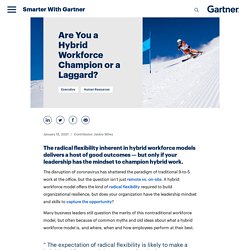
The disruption of coronavirus has shattered the paradigm of traditional 9-to-5 work at the office, but the question isn’t just remote vs. on-site. A hybrid workforce model offers the kind of radical flexibility required to build organizational resilience, but does your organization have the leadership mindset and skills to capture the opportunity?
Many business leaders still question the merits of this nontraditional workforce model, but often because of common myths and old ideas about what a hybrid workforce model is, and where, when and how employees perform at their best. The expectation of radical flexibility is likely to make a hybrid workforce model more prevalent in the post-COVID-19 world. Employees Are Lonelier Than Ever. Here’s How Employers Can Help. Le télétravail : miroir des lacunes de nos organisations. Collaboration in Hybrid Work Environments Takes Intentional Effort. Hybrid work environments provide new ways for employees to collaborate productively, but leaders must intentionally create those opportunities.
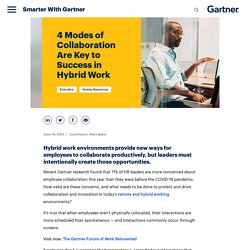
Recent Gartner research found that 71% of HR leaders are more concerned about employee collaboration this year than they were before the COVID-19 pandemic. How valid are these concerns, and what needs to be done to protect and drive collaboration and innovation in today’s remote and hybrid working environments? It’s true that when employees aren’t physically colocated, their interactions are more scheduled than spontaneous — and interactions commonly occur through screens.
Anxious About Hybrid Work? Ask Yourself These 4 Questions. The Future of Work: Five Game Changers – Policy Horizons Canada. On this page Foreword The coming decades will bring significant changes to the nature of work, including what, how, where, and by whom work will be done.

Artificial intelligence, automation, and telepresence can disrupt work as we know it and impact employment levels. Moreover, as more technologies mature and combine, we could see changes to the fundamental organizing principles of the economy, impacting the nature of work. The disruptions to the quantity and quality of work could go beyond any levels we have experienced to date. 4 tools to help managers connect with remote teams. If the idea of working remotely — whether permanently or for even longer than you already have — has you feeling overwhelmed, think small. In their new book “Remote, Inc.,” MIT Sloan senior lecturer Robert Pozen, and tech and data writer Alexandra Samuel, encourage everyone from early career-goers to managers to adopt both “the mindset and habits of a small business owner.”
“That’s because every single home office is, essentially, its own freestanding enterprise,” the authors write. “Thinking of yourself as Remote, Inc. means you have the responsibility and accountability of a business owner, but also the flexibility and independence.” Hybrid Workforce Champions Succeed. Hybrid Work is Here to Stay. Learn Effective Ways to Set Ground Rules. Use these common-sense approaches to combat anxiety and boost unity and efficiency for hybrid and remote teams. By 2022, 25% of the global knowledge workforce will choose their home as the primary workplace, and 45% of the workforce will be working from home two to three days per week. Some employees are thrilled at the prospect. Others, not so much. For many employees, the novelty of working from home has already worn off, and they’re anxious about the possibility of a permanent move to a hybrid work environment.
You can help reduce their anxiety with some simple ground rules for virtual interactions and other work challenges that are unique to remote and hybrid work teams.
How to Set Up a Remote Employee for Success on Day One. Most managers know that onboarding new employees virtually is just plain hard, and many recognize the long-term impact a poor onboarding experience could have on their employees. Onboarding is more than logistics, such as making sure your new employee has a computer. The more critical, make-or-break parts of onboarding include: Coronavirus (COVID-19): Guide to providing virtual work experience placements. We are facing uncertain times, but especially for young people looking to the future. Since the start of the COVID-19 pandemic, unemployment for young people has increased by 13% (66,000 young people) according to the UK Government’s youth unemployment statistics. Before the pandemic, youth unemployment was at an all-time low. Now, the number of young people uncertain of their next steps after leaving education is increasing, and an estimated 11.2% of young people aged 16–24 were NEET (not in education, employment or training after leaving school) in early 2021.
COLLECTION - Information on Flexible Working. Flexible working for me, means working how I want, when I want with who I want and for as long as I want. It's just taking that slightly different attitude that I might need that bit of flexibility as an employee. It's not about presentism, it’s not about what time you turn up at work and what time you finish. Allowing people the flexibility to work from home, work different hours. I can work when I want to work. Flexible working – lessons from the pandemic.
Research: Dispersed Teams Succeed Fast, Fail Slow. Don’t Let Employees Pick Their WFH Days.